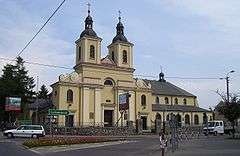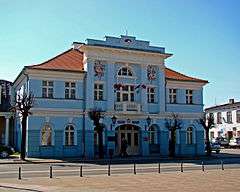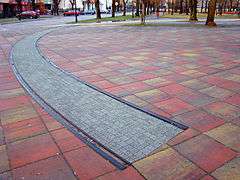Aleksandrów Łódzki
| Aleksandrów Łódzki | |||
|---|---|---|---|
|
Kościuszko Square in Aleksandrów Łódzki | |||
| |||
 Aleksandrów Łódzki | |||
| Coordinates: 51°49′N 19°18′E / 51.817°N 19.300°E | |||
| Country |
| ||
| Voivodeship | Łódź | ||
| County | Zgierz | ||
| Gmina | Aleksandrów Łódzki | ||
| Established | 19th century | ||
| Town rights | 1822 | ||
| Government | |||
| • Mayor | Jacek Lipiński | ||
| Area | |||
| • Total | 13.47 km2 (5.20 sq mi) | ||
| Elevation | 206 m (676 ft) | ||
| Population (2002) | |||
| • Total | 20,220 | ||
| • Density | 1,500/km2 (3,900/sq mi) | ||
| Time zone | CET (UTC+1) | ||
| • Summer (DST) | CEST (UTC+2) | ||
| Postal code | 95-069 to 95-070 | ||
| Area code(s) | +48 42 | ||
| Car plates | EZG | ||
| Website | http://www.aleksandrow-lodzki.pl | ||
Aleksandrów Łódzki [alɛkˈsandruf ˈwut͡skʲi](![]() listen) - is a town in Łódzkie Voivodship and belongs to Łódź agglomeration. According to data gathered on 20 May 2002, the town had a population of 20,220.
listen) - is a town in Łódzkie Voivodship and belongs to Łódź agglomeration. According to data gathered on 20 May 2002, the town had a population of 20,220.
History

The village was founded in 1816 by Rafał Bratoszewski. In 1820, Rajmund Rembieliński called Aleksandrów "one of the better towns in Poland". Bernard von Schuttenbach was the author of the town planning project. In order to gain sympathy of the government, Bratoszewski called the town after the then ruling Russian Emperor Alexander I Romanov. This resulted in Aleksandrów gaining the city rights in 1822. After the Bratoszewski s death in 1824 the Kossowski family took over the town.
After 1832, the town began to fall back economically overwhelmed by the nearby towns of Pabianice, Zgierz and Łódź. In the late 19th century and early 20th century, many knitting companies were founded in Aleksandrów, so it is called the cradle of the Polish stocking industry and also gained the nickname "Sock-city" among the citizens. This trade is still the main one today. In 1910, the town gained a tram connection with Łódź, which was discontinued in 1991.


From the beginning, Aleksandrów was a town of three cultures and three religions. There were Protestant descendants of German knitters, Jews who were in trade and, of course, Catholic Poles who mainly worked as craftsmen and in factories. Until 1945, the richest and most numerous ethnic group were Germans. The Jewish population in 1900 was 1,673.[1] For the Jewish, Aleksandrów was an important religious centre - the seat of Hasidic Tzadikim of the Alexander dynasty founded by Rabbi Yechiel Dancyger (1828–1894). It was also where Rabbi Chanokh Heynekh HaKohen Levin, the second Rebbe of the Ger Hasidim held court until his death in Aleksandrów in 1870.
In 1869, during the partitions of Poland, Aleksandrów lost its city rights lasting for more than 60 years. These rights were regained in 1924 in the newly reborn Poland. Currently, it is the seat of the Aleksandrów Łódzki county. In September 2006, the first International Convention of Aleksandrów citizens was held.
Industry
Currently, there are 2,623 registered companies in Aleksandrów. The textile industry constitutes 38% of the economy, trade - 24%, vehicle mechanics and transport - 5%, and other - 33%.

Tourism
The most notable and oldest monuments of Aleksandrów are:
- St. Rafael and Michael Catholic church - built in 1816–1818, rebuilt three times (1922-1926 - two aisles added; 1933-1935 - two towers added; 1993 - added a second nave with its own altar). Under the church, lies buried Rafał Bratoszewski - founder of Aleksandrów.
- Evangelic church - built in 1828 by pastor Fryderyk Jerzy Tuve, never modified. Unfortunately it is currently in a very bad condition, but renovation is imminent.
- The City Shops "Jatki" - rebuilt in 1998, formerly a place for butchers and bakers to sell their goods; now part of the Town Hall.
- The Town Hall - built in 1824. Still serves its function today.
- The library - originally the house of a pastor built in 1848.
- The oldest grave - dating from 1830, the place of burial for Fryderyk Jerzy Tuve. There is also a Jewish cemetery in the northern part of the town with graves of Hasidic Tzadiks.
- The city park - an English-styled garden founded by Rafał Bratoszewski in 1824.
- Weaver houses - long wooden houses of the first settlers from the first half of the 19th century.
Other monuments:
- Albert Stiller's factory and villa - built in 1908, one of the most modern factories of its times along with a stylish villa.
- Dormitory of Nicolaus Copernicus High School, a former mansion of Hasidic Tzadiks from Danziger dynasty, built in 1935.
Sports
- Towarzystwo Sportowe Sokół-Syguła. Founded in 1998, with soccer and karate sections. Stanisław Syguła is the chairman and main sponsor of the club.
- MULKS Aleksandrów - established in 2004 - youth soccer
- MKS Aleksandrów - track and field athletics
- UKS Jedynka - volleyball
- Sporting events
- Józef Jaworski track and field memorial - held annually since 1983
Local media
- 40 i cztery (title is a reference to the tram line number 44 that connected Aleksandrów with Łódź) monthly bulletin issued by the local commune. It has appeared since 8 December 1991 formerly as a biweekly. Current editor-in-chief - Dorota Bełdowska-Zemła
- Alternatywy 44 monthly bulletin issued by the Aleksandrów Association of Entrepreneurs 2000. Current editor-in-chief - Tomasz Dominowski.
- Wiadomości aleksandrowskie bulletin of St. by Rafael and Michael parish initiated by Rev. dr Norbert Rucki
- Aleksandrów wczoraj i dziś (Aleksandrów yesterday and today) A yearly publication appearing since 1983 on behalf of Friends of Aleksandrów Association. Current editor-in-chief - Zenon Kozanecki.
- Gazeta Matusiaka, independent newspaper issued by Grzegorz Matusiak in 1992–2004.
- TELETOP TV
Twins cites
References
External links
![]() Media related to Aleksandrów Łódzki at Wikimedia Commons
Media related to Aleksandrów Łódzki at Wikimedia Commons
- Articles on history of Aleksandrów
- Tourism in Aleksandrów
- Aleksandrów Łódzki Yizkor (Holocaust Memorial) Book (Yiddish and Hebrew)
Coordinates: 51°49′N 19°18′E / 51.817°N 19.300°E


